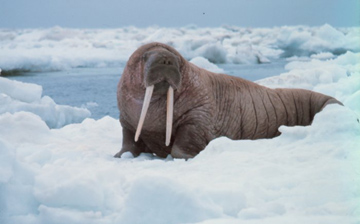Whales and walruses might not seem like they have much in common. But for a couple of centuries, they shared a common fate: They were hunted to near-extinction by whaling fleets. Walruses were prized for their blubber, which was rendered down to make oil; their tough skins; and their ivory tusks.
 Large walrus on the ice. Credit: National Oceanic and Atmospheric Administration
Large walrus on the ice. Credit: National Oceanic and Atmospheric AdministrationThere are two main groups of walruses. The Pacific walrus inhabits the waters near Russia and Alaska. Thanks to restrictions on hunting, its population has rebounded to a couple of hundred thousand. The Atlantic walrus, which lives around Canada and Greenland, is protected, too. Yet its population is only around 20,000 — down from perhaps hundreds of thousands a couple of centuries ago.
The Atlantic walrus is the smaller species. Males grow to about 8 to 10 feet long, and weigh about 3,000 pounds. The walruses live on the pack ice during winter, and come ashore during summer. They use their sensitive whiskers to find clams on the dimly lit ocean floor.
Walruses are best known for their tusks, which can grow up to three feet long. They use the tusks to pull themselves out of the water and onto the ice, and to chip breathing holes from below the ice. And during mating season, males use their tusks as weapons.
Atlantic walruses may have made a small comeback in recent years. But native populations in Canada and Greenland are allowed to kill a few hundred each year. And a warmer climate is reducing the ice where they live in the winter — another challenge for a species that’s just hanging on.

